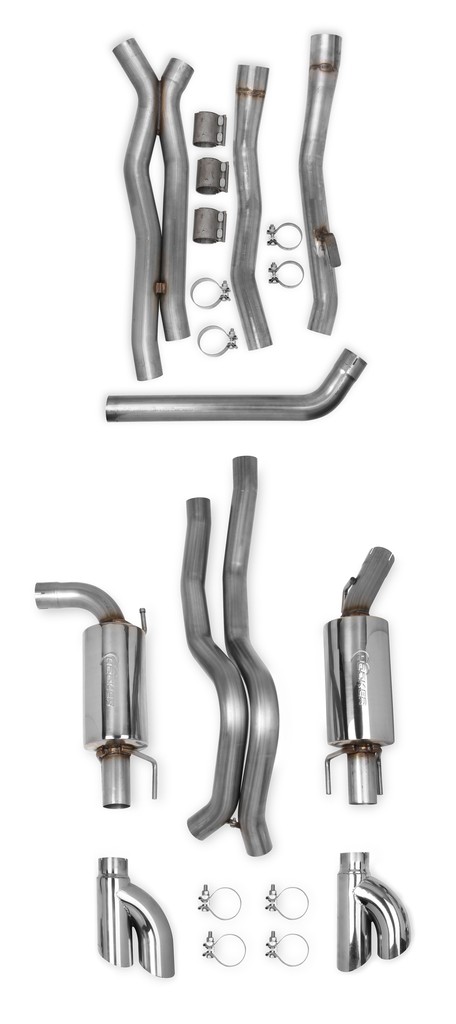Engine Masters Exaust Experiment
#1
Supreme Member

Thread Starter
Engine Masters Exaust Experiment
Not quite scientific but it demonstrates what we've known (or should have known) all along.
Once you watch it, consider the results at a more modest power level and a single 3" as is more typical of a 3rd gen (like mine!).
Once you watch it, consider the results at a more modest power level and a single 3" as is more typical of a 3rd gen (like mine!).
Last edited by skinny z; 05-20-2016 at 10:16 PM.
#2
Supreme Member
Join Date: Apr 2013
Location: North Salt Lake
Posts: 1,353
Likes: 0
Received 1 Like
on
1 Post
Car: '86 Camaro, '94 Camaro, 3 others
Engine: LG4 ->L29, L32->LR4, L36, LG4, L31
Transmission: 700R-4, T5WC, 4L80E, SM465, 4L60E
Axle/Gears: 3.42, 3.23, WTB/WTT 2.93
Re: Engine Masters Exaust Experiment
Theory says a 2.5" single straight pipe should support 260 hp with no restriction, any more than that should have backpressure, which they didn't't measure. What this illustrated to me is the impact at running maybe 14% more than the theoretical ideal. It cost about 6%.
#3
Supreme Member

Thread Starter
Re: Engine Masters Exaust Experiment
The theoretical ideal is an open header with the proper length collector.(That length is engine dependant).
The ultimate goal is zero back pressure. A properly "tuned" exhaust will have negative pressure pulses that are timed to arrive at the exhaust valve at the correct time. That's very difficult to do with a full exhaust system.
The point here is the less restriction the better.
The ultimate goal is zero back pressure. A properly "tuned" exhaust will have negative pressure pulses that are timed to arrive at the exhaust valve at the correct time. That's very difficult to do with a full exhaust system.
The point here is the less restriction the better.
#4
Supreme Member
Join Date: Apr 2013
Location: North Salt Lake
Posts: 1,353
Likes: 0
Received 1 Like
on
1 Post
Car: '86 Camaro, '94 Camaro, 3 others
Engine: LG4 ->L29, L32->LR4, L36, LG4, L31
Transmission: 700R-4, T5WC, 4L80E, SM465, 4L60E
Axle/Gears: 3.42, 3.23, WTB/WTT 2.93
Re: Engine Masters Exaust Experiment
No, the ideal isn't zero backpressure, it's maximum output from the engine. Backpressure is a helpful tool, much like DCR is a tool rather than a goal. Take their results and divide by 2 for a typical mild 350, the single 3" would be 307 HP, 2.5" would be what, right at 300? That's actually around 2.5% loss, not a big deal. The extra 7 horses are useless if you can't use them because they wake the police.
#5
Supreme Member

Thread Starter
Re: Engine Masters Exaust Experiment
My understanding of engine theory differs from yours then.
Backpressure serves no useful purpose in an exhaust other than to inhibit the flow of gases. And that's not useful.
Don't confuse backpressure with pressure wave pulses. Those pulses, specifically those of a negative pressure (that is:below atmospheric) contribute to cylinder scavenging during the overlap period of the cam cycle. The ultimate muffled exhaust lsystem is one which duplicates that of an open header. Not easily done but doable nonetheless. And it won't wake the neighbours either.
Your 270 hp example wouldn't benefit from such a system as would a 500hp engine that has a cam with sufficient overlap. And I'm referring to a typical 23 degree SBC cylinder head here.
Backpressure serves no useful purpose in an exhaust other than to inhibit the flow of gases. And that's not useful.
Don't confuse backpressure with pressure wave pulses. Those pulses, specifically those of a negative pressure (that is:below atmospheric) contribute to cylinder scavenging during the overlap period of the cam cycle. The ultimate muffled exhaust lsystem is one which duplicates that of an open header. Not easily done but doable nonetheless. And it won't wake the neighbours either.
Your 270 hp example wouldn't benefit from such a system as would a 500hp engine that has a cam with sufficient overlap. And I'm referring to a typical 23 degree SBC cylinder head here.
#6
Supreme Member
Join Date: Apr 2013
Location: North Salt Lake
Posts: 1,353
Likes: 0
Received 1 Like
on
1 Post
Car: '86 Camaro, '94 Camaro, 3 others
Engine: LG4 ->L29, L32->LR4, L36, LG4, L31
Transmission: 700R-4, T5WC, 4L80E, SM465, 4L60E
Axle/Gears: 3.42, 3.23, WTB/WTT 2.93
Re: Engine Masters Exaust Experiment
If you want to pick nits, then what they spent on the headers and muffs would have been better spent on manifolds and a turbo. More power, less noise, and tons more backpressure.
#7
Supreme Member

Thread Starter
Re: Engine Masters Exaust Experiment
That wasn't the point.
But there are lots of places money could ne spent elsewhere.
But there are lots of places money could ne spent elsewhere.
Trending Topics
#8
Member

iTrader: (1)
Join Date: Dec 2001
Location: Finland
Posts: 456
Likes: 0
Received 2 Likes
on
2 Posts
Car: 1985 Camaro Z-28
Engine: 385
Transmission: th700r4+Edge 2800 stall
Axle/Gears: 3.42
Re: Engine Masters Exaust Experiment
At this article they also tested 2-1/2" vs 3" exhaust.
http://www.hotrod.com/how-to/additio...rmarket-parts/
http://www.hotrod.com/how-to/additio...rmarket-parts/
#9
Supreme Member

Thread Starter
Re: Engine Masters Exaust Experiment
Hadn't seen that one before Jari. I'll have to check it out.
One thing I know for certain is that the single 3" exhaust and muffler aren't doing my engine any favours. I'll definitely be investing in Hookers new Blackheart duals. Probably next winter's project along with a new converter.
One thing I know for certain is that the single 3" exhaust and muffler aren't doing my engine any favours. I'll definitely be investing in Hookers new Blackheart duals. Probably next winter's project along with a new converter.
#10
Re: Engine Masters Exaust Experiment
I just finished helping a friend install the holley blackheart kit on his 84 sport coupe. He has a 383 roller motor that is pushing 550hp. He is running hedman long tubes and a built th350 with a bmr trans x-member. The good news is the holley kit fit like a glove and quality was excellent (at least the back half). The bad news is the kt is only made for LS motors running their headers and x-member and comes only in 2.5".
We had to do away with the mid pipe/ x-pipe and the front pipes from the headers. Because he is running the shorter th350 trans I was able to fab up front pipes that went along side the trans pan and OVER the x-member. It was a tight fit but managed to clear the driveshaft. The mid pipes were replaced with straight 2.5" tubing and with some judicious massaging of the right side rear floor they tucked up nicely. The exhaust sits higher than his Moroso sfc's.
The problem with the blackheart system is that the pipes at the front of the mid pipe splay out at very sharp angles. Running any kind of OD trans like 700R4 forces you to go under and/or around the x-member and frame rails. Doing that kills the ground clearance.
So if you are willing to spend nearly $800.00 on the exhaust and throw half of it away you can make a good fitting, nice sounding true dual exhaust system. There would definitely be a benefit to switching from a single 3" to true dual 2.5" system as the combined cross sectional area of the dual 2.5" kit is 39.25in/sq and the area of a single 3" system is 28.26in/sq.
We had to do away with the mid pipe/ x-pipe and the front pipes from the headers. Because he is running the shorter th350 trans I was able to fab up front pipes that went along side the trans pan and OVER the x-member. It was a tight fit but managed to clear the driveshaft. The mid pipes were replaced with straight 2.5" tubing and with some judicious massaging of the right side rear floor they tucked up nicely. The exhaust sits higher than his Moroso sfc's.
The problem with the blackheart system is that the pipes at the front of the mid pipe splay out at very sharp angles. Running any kind of OD trans like 700R4 forces you to go under and/or around the x-member and frame rails. Doing that kills the ground clearance.
So if you are willing to spend nearly $800.00 on the exhaust and throw half of it away you can make a good fitting, nice sounding true dual exhaust system. There would definitely be a benefit to switching from a single 3" to true dual 2.5" system as the combined cross sectional area of the dual 2.5" kit is 39.25in/sq and the area of a single 3" system is 28.26in/sq.
#11
Supreme Member

Thread Starter
Re: Engine Masters Exaust Experiment
I realize that's it's targeted to the LSX swap crowd. Right down to the engine mounts and crossmember. What I had hoped was only fabricating from the headers to the x-portion of the mid-pipes would be all that was needed. The cross-over is an essential part of the assembly.
My intention is to build the exhaust first and then build a crossmember to go around it. Maybe even something that's capable of supporting my 700R4 this season and the inevitable 4L60/65E next season without having to cut up or modify anything. I find it easier to build the crossmember to suit the exhaust than the other way around.
My intention is to build the exhaust first and then build a crossmember to go around it. Maybe even something that's capable of supporting my 700R4 this season and the inevitable 4L60/65E next season without having to cut up or modify anything. I find it easier to build the crossmember to suit the exhaust than the other way around.
#12
Senior Member

iTrader: (3)
Join Date: Jun 2002
Location: MA
Posts: 564
Received 0 Likes
on
0 Posts
Car: 1982 Z-28
Engine: 383
Transmission: Turbo 350
Axle/Gears: Det. Posi, Superior Axles, 3:73 G
Re: Engine Masters Exaust Experiment
I did ask Hooker if maybe, eventually, they may make this kit for their L/T 2210, but was told it was not in the process.
The exhaust does sound great and looks great too, but I didn't like hearing about 1/2 upfront was redone. If I'm spending $800-900 on just the exhaust, I'd hope for a full kit. Just my
The exhaust does sound great and looks great too, but I didn't like hearing about 1/2 upfront was redone. If I'm spending $800-900 on just the exhaust, I'd hope for a full kit. Just my

#13
Re: Engine Masters Exaust Experiment
I realize that's it's targeted to the LSX swap crowd. Right down to the engine mounts and crossmember. What I had hoped was only fabricating from the headers to the x-portion of the mid-pipes would be all that was needed. The cross-over is an essential part of the assembly.
My intention is to build the exhaust first and then build a crossmember to go around it. Maybe even something that's capable of supporting my 700R4 this season and the inevitable 4L60/65E next season without having to cut up or modify anything. I find it easier to build the crossmember to suit the exhaust than the other way around.
My intention is to build the exhaust first and then build a crossmember to go around it. Maybe even something that's capable of supporting my 700R4 this season and the inevitable 4L60/65E next season without having to cut up or modify anything. I find it easier to build the crossmember to suit the exhaust than the other way around.
Passenger side
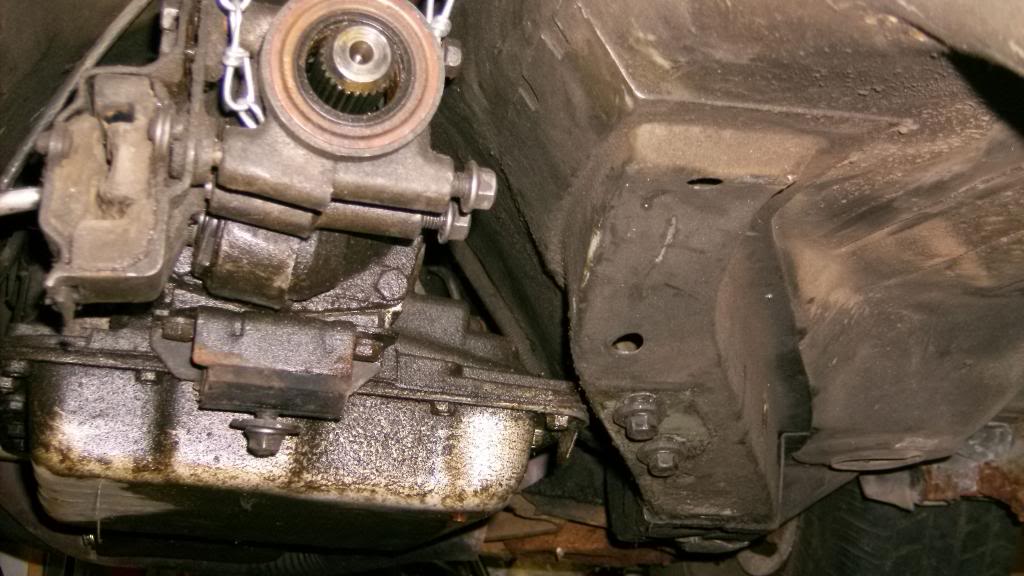
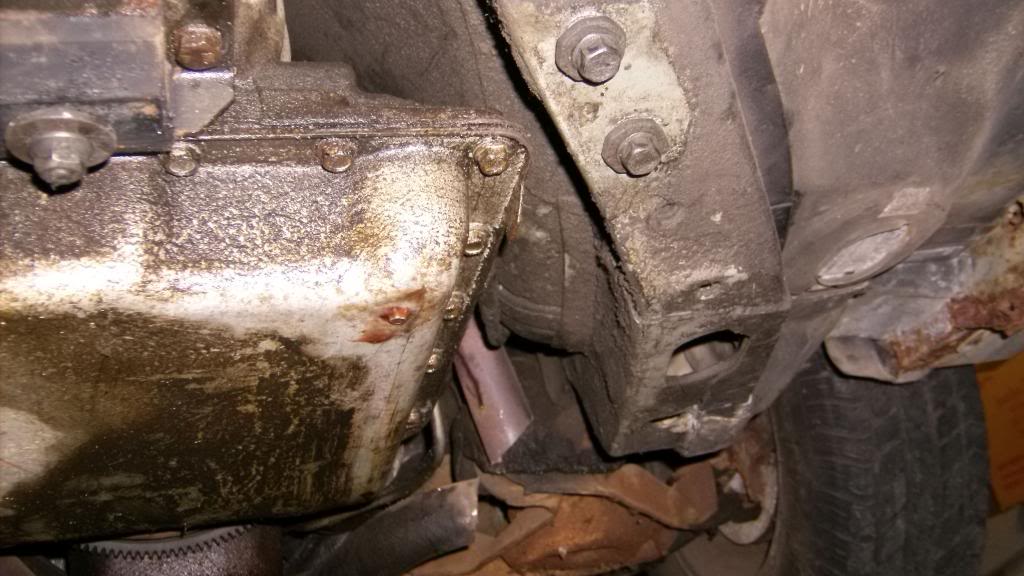
Driver side
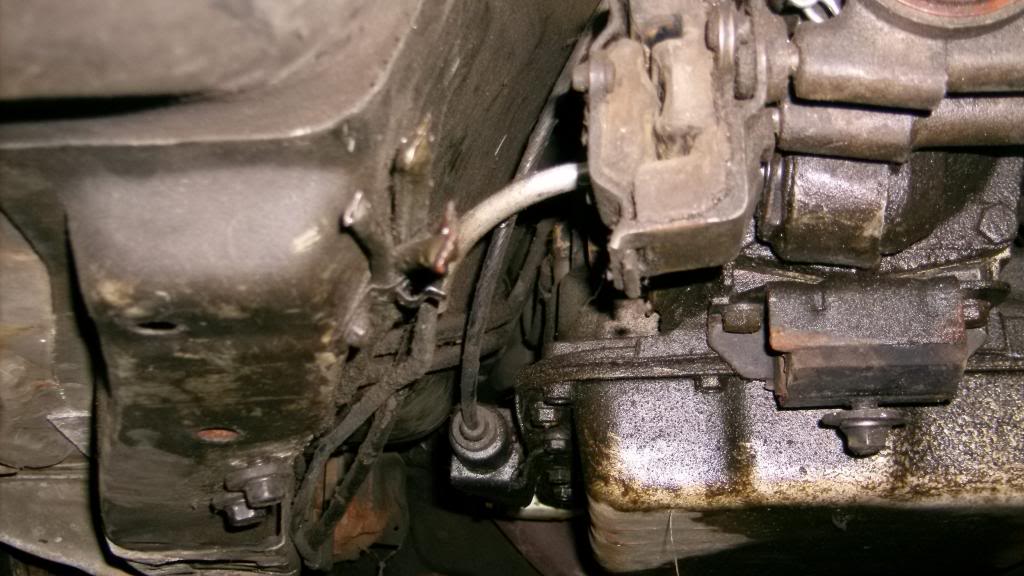
Notice I have removed the stock x-member. To get pipes to the long tube headers you have to go under the frame and trans pan (especially on the passenger side and that kills the ground clearance. You could possibly go around the frame and route both sides out toward the rockers similar to how factory ran the exhaust on passenger side and hook back up to some shorty or mid length headers.
#15
Re: Engine Masters Exaust Experiment
Not quite scientific but it demonstrates what we've known (or should have known) all along.
Once you watch it, consider the results at a more modest power level and a single 3" as is more typical of a 3rd gen (like mine!).
The Power of 2.5- vs. 3-Inch Exhaust - Engine Masters Ep. 9 - YouTube
Once you watch it, consider the results at a more modest power level and a single 3" as is more typical of a 3rd gen (like mine!).
The Power of 2.5- vs. 3-Inch Exhaust - Engine Masters Ep. 9 - YouTube
#16
Supreme Member

Re: Engine Masters Exaust Experiment
Whereas, Turbo vehicles have the advantage of higher than atmospheric pressure on the intake side, so although the additional backpressure of the turbine negatively influences flow there and arguably cancels/disregards much of acoustic tuning(and it acts as a muffler sort of), there is increased flow on the intake side of things and higher pressure which helps overall move more air total volume at higher pressure through the engine, and with it hopefully mass flow.
Just to tie this up neatly in a bow: coating/wrap the exhaust to maintain all of the temperature inside, then set the max temp using meth/water injection like a thermostat, is the ideal performance for exhaust system while Turbo because the higher inside temps yield faster exhaust velocity and decreased IAT (since it is not being radiated to the engine bay where it heats everything else up "heat soak")
Last edited by Kingtal0n; 06-02-2016 at 02:17 PM.
#17
Supreme Member

Thread Starter
Re: Engine Masters Exaust Experiment
This is the point of view to have, where natural aspiration in street cars is going to rely heavily on exhaust "tuning" as you have been pointing out, those waves are acoustic (sound) and assist with "scavenging" (essentially a tiny vacuum cleaner to the exhaust valve at the right instant) and together with a smaller diameter plumbing will support the mid-range of an engine in a street car that is N/A. A true race car would see more benefit from a larger tube, giving up its mid-range exhaust gas velocity for pure high RPM output, where exhaust flow should peak if the engine is truly a race engine with highest VE at highest RPM. Acoustics can also play a roll here, but I believe that of bigger importance to those kind of engines is the momentum of flow, i.e. tunnel ram type of designs which depend heavily on the quickly moving airflow with no tight bends to fill a cylinder beyond 100%VE using only the atmosphere. It makes a poor street car because at anything except max RPM/power the engine will be sluggish, and have poor control over the air velocity, especially with a large camshaft duration.
Whereas, Turbo vehicles have the advantage of higher than atmospheric pressure on the intake side, so although the additional backpressure of the turbine negatively influences flow there and arguably cancels/disregards much of acoustic tuning(and it acts as a muffler sort of), there is increased flow on the intake side of things and higher pressure which helps overall move more air total volume at higher pressure through the engine, and with it hopefully mass flow.
Just to tie this up neatly in a bow: coating/wrap the exhaust to maintain all of the temperature inside, then set the max temp using meth/water injection like a thermostat, is the ideal performance for exhaust system while Turbo because the higher inside temps yield faster exhaust velocity and decreased IAT (since it is not being radiated to the engine bay where it heats everything else up "heat soak")
Whereas, Turbo vehicles have the advantage of higher than atmospheric pressure on the intake side, so although the additional backpressure of the turbine negatively influences flow there and arguably cancels/disregards much of acoustic tuning(and it acts as a muffler sort of), there is increased flow on the intake side of things and higher pressure which helps overall move more air total volume at higher pressure through the engine, and with it hopefully mass flow.
Just to tie this up neatly in a bow: coating/wrap the exhaust to maintain all of the temperature inside, then set the max temp using meth/water injection like a thermostat, is the ideal performance for exhaust system while Turbo because the higher inside temps yield faster exhaust velocity and decreased IAT (since it is not being radiated to the engine bay where it heats everything else up "heat soak")
As for the exhaust tuning in a NA engine, therein lies the rub. Without some real ingenuity, as in an exhaust termination/resonator boxes, it's more or less impossible to take advantage of the pressure wave pulses and trying to get that "essentially a tiny vacuum cleaner to the exhaust valve at the right instant" when a full exhaust system is to be incorporated. It has been done and to good effect (so I've read) but the available real estate on a 3rd gen doesn't leave much for true duals let alone designs along the lines of termination boxes. The best I figure I can do, which is probably as good as it gets pulse tuning-wise, is to establish collector cut-outs at the appropriate length and let the harmonics do their job.
#18
Supreme Member

Thread Starter
Re: Engine Masters Exaust Experiment
Skinny Z you could probably cut off just ahead if the x-pipe and have very short forward facing stubs that you could build forward from there. The picture on Holley's web site is accurate so you can see how they splay out at very sharp angles. The biggest problem, especially with running a 700R4 or 4L60 type OD trans is there is just no room in the trans tunnel for exhaust pipes. The factory frame rails taper in and close off the tunnel at the back of the trans oil pan. See pics below.
Passenger side
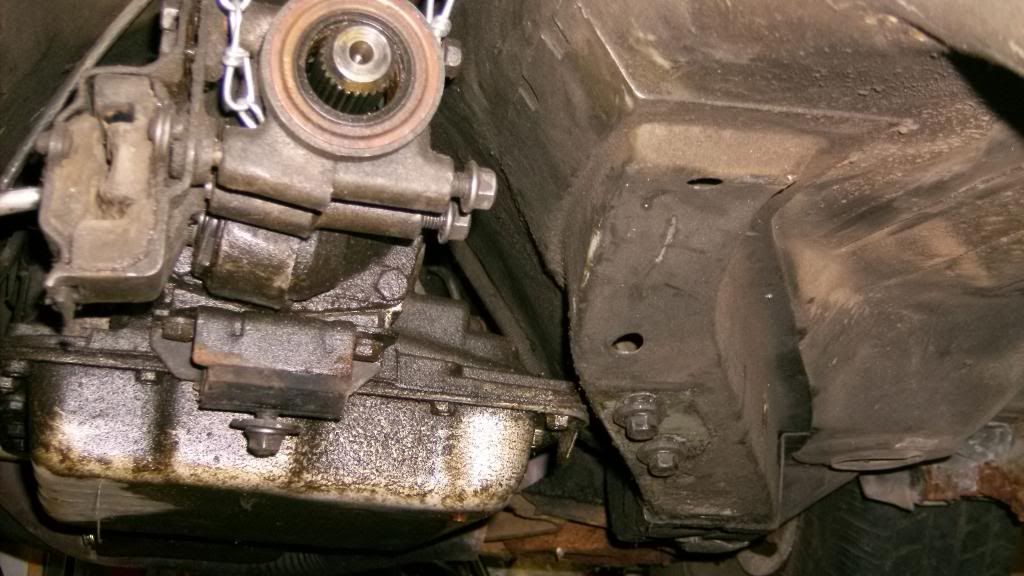
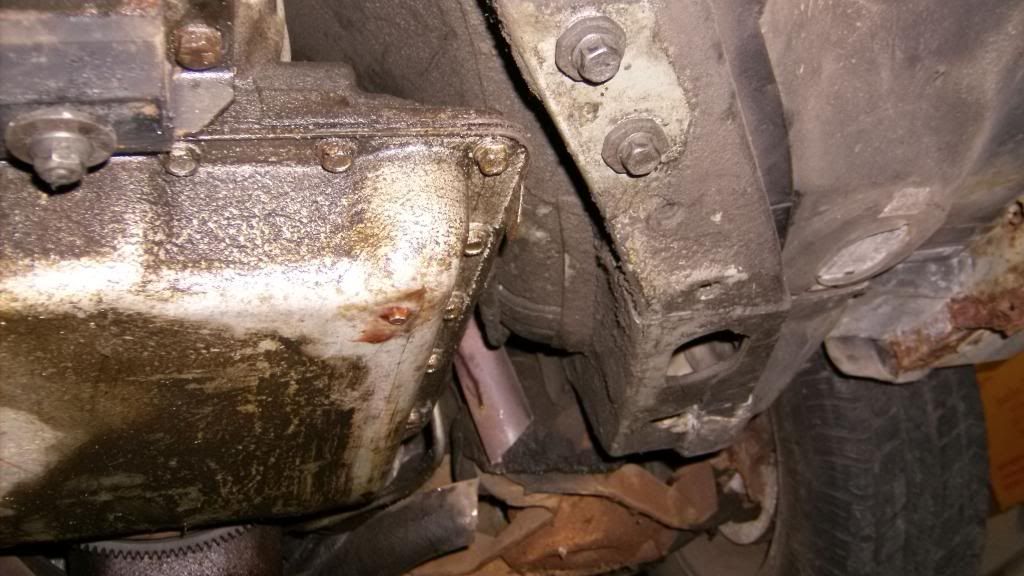
Driver side
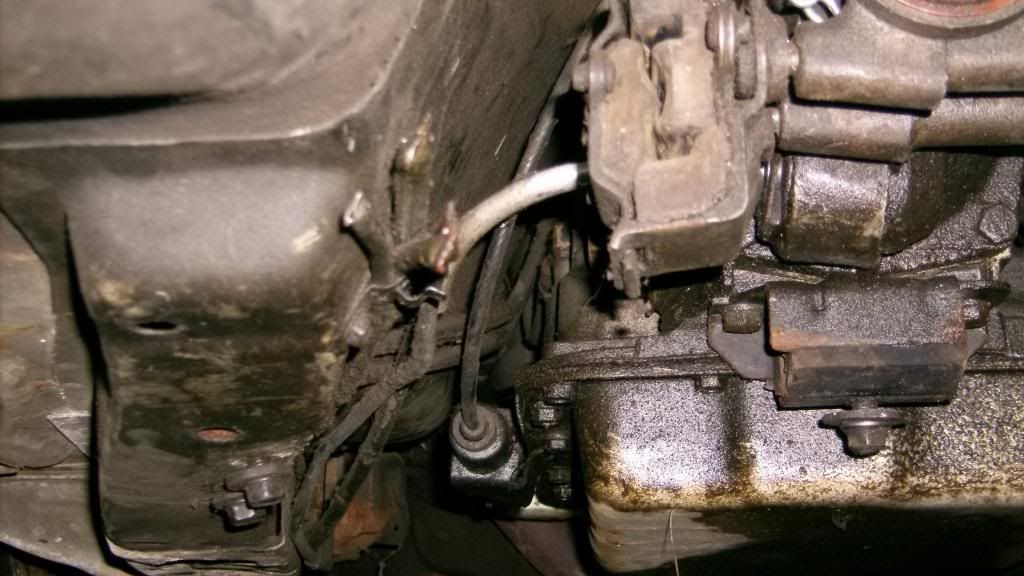
Notice I have removed the stock x-member. To get pipes to the long tube headers you have to go under the frame and trans pan (especially on the passenger side and that kills the ground clearance. You could possibly go around the frame and route both sides out toward the rockers similar to how factory ran the exhaust on passenger side and hook back up to some shorty or mid length headers.
Passenger side


Driver side

Notice I have removed the stock x-member. To get pipes to the long tube headers you have to go under the frame and trans pan (especially on the passenger side and that kills the ground clearance. You could possibly go around the frame and route both sides out toward the rockers similar to how factory ran the exhaust on passenger side and hook back up to some shorty or mid length headers.

2 1/2" stainless y-pipe

Modified OEM crossmember

Y-pipe into Magnaflow merge

Ground clearance at lowest point (Chassis with 1 1/2" drop)
#19
Supreme Member

Re: Engine Masters Exaust Experiment
That's my hope anyway.
But to compare a NA vehicle to a Turbo car is hardly apples to apples.
As for the exhaust tuning in a NA engine, therein lies the rub. Without some real ingenuity, as in an exhaust termination/resonator boxes, it's more or less impossible to take advantage of the pressure wave pulses and trying to get that "essentially a tiny vacuum cleaner to the exhaust valve at the right instant" when a full exhaust system is to be incorporated. It has been done and to good effect (so I've read) but the available real estate on a 3rd gen doesn't leave much for true duals let alone designs along the lines of termination boxes. The best I figure I can do, which is probably as good as it gets pulse tuning-wise, is to establish collector cut-outs at the appropriate length and let the harmonics do their job.
But to compare a NA vehicle to a Turbo car is hardly apples to apples.
As for the exhaust tuning in a NA engine, therein lies the rub. Without some real ingenuity, as in an exhaust termination/resonator boxes, it's more or less impossible to take advantage of the pressure wave pulses and trying to get that "essentially a tiny vacuum cleaner to the exhaust valve at the right instant" when a full exhaust system is to be incorporated. It has been done and to good effect (so I've read) but the available real estate on a 3rd gen doesn't leave much for true duals let alone designs along the lines of termination boxes. The best I figure I can do, which is probably as good as it gets pulse tuning-wise, is to establish collector cut-outs at the appropriate length and let the harmonics do their job.
The acoustic tuning thing is something manufacturers are doing to improve their engine's economy/performance for 'free' since they are mass producing the parts anyways, it helps to mass produce them with any additional benefits these days (modern engines) since everybody has an engine to sell, which one gives you the best result is up to those tiny improvements the engineers can find anywhere they can find them.
More important than tuning/resonance features, is strictly exhaust sizing. You want the velocity to be highest where you will drive the car the most. If that is a street car usually this range is 2500-4000rpm, so naturally a dual 3" is far too large. A single 3" downpipe can support over 500 horsepower behind a turbo for example. Most naturally aspirated engines running dual exhaust in the 4-6L range only require 2.5 or even 2.25" diameter duals, assuming they wish to max that given range of 2500-4500. If the engine spends alot of time at max performance rpm (5000+) then of course it will enjoy a larger exhaust for lower pressure and similar velocity (trade off between velocity and pressure) but most of us street our cars, and our thinking of "larger exhaust / lower pressure" is hurting low rpm performance more than many realize.
#20
Supreme Member

Thread Starter
Re: Engine Masters Exaust Experiment
NA and turbo cars are not so far off as you think. atmospheric pressure fluctuates depending on altitude and even time of day, just like you can drive up a mountain or drive down a mountain, those changes are exactly like what a turbocharger cause to occur in the intake manifold. You can even think of it as driving down below sea level for extra pressure. It just also happens to get hotter as you descend.
.
.
More important than tuning/resonance features, is strictly exhaust sizing. You want the velocity to be highest where you will drive the car the most. If that is a street car usually this range is 2500-4000rpm, so naturally a dual 3" is far too large. A single 3" downpipe can support over 500 horsepower behind a turbo for example. Most naturally aspirated engines running dual exhaust in the 4-6L range only require 2.5 or even 2.25" diameter duals, assuming they wish to max that given range of 2500-4500. If the engine spends alot of time at max performance rpm (5000+) then of course it will enjoy a larger exhaust for lower pressure and similar velocity (trade off between velocity and pressure) but most of us street our cars, and our thinking of "larger exhaust / lower pressure" is hurting low rpm performance more than many realize.
Exhaust sizing.
The general rule of thumb is a given amount of CFM per HP developed by the engine. 2.2 CFM/HP (which includes the entire exhaust system) is a number that has been generally accepted as the minimum value before backpressure starts to limit power output.
The target here is zero backpressure.
That said, it's very difficult to calculate how many CFM a given number of bends, an overall length of pipe and a muffler is capable of flowing. It would have to be tested on a bench or sized large enough that we're certain it has sufficient capacity.
Now add to this trying to incorporate the tuning. If we get the length of pipe correct, which can be calculated from collector to tailpipe and taking into account the type of muffler(s) used, then we can time the low pressure pulse to arrive at the exhaust valve at the right moment. If the diameter, or more specifically, the CFM capabilities of the entire exhaust system are adequate, then velocity should be at it's highest as the volumetric efficiency is at it's greatest and thus the amount to be exited from the engine is also at it's highest value.
How does a system deemed "too large" have any effect on that?
#21
Supreme Member

Re: Engine Masters Exaust Experiment
i have to agree, the formula for exhaust size to HP is for straight pipe. it doesnt account for bends or mufflers.
#22
Supreme Member

Re: Engine Masters Exaust Experiment
Exhaust sizing.
For us the situation is more difficult because we lack test benches and manufacturing facilities. Any amount of number crunching for all but the easy to model situations will not likely yield anything that we could expect to design and implement one single time, such an attempt would undoubtedly require multiple versions and attempts for the same reasons the manufacturer does it. Remember that valve timing will influence how the engine deals with exhaust flow, so even the best pipe length calculation needs to correlate with engine valvetrain dynamics unless we are just asking coincidence to occur, yay for coincidence sometimes.
I can tell you from reading that some would suggest the proper plumbing diameter could have as much as 15 times the pull on a cylinder during overlap that the ascending piston exerts. I think that was David Vizard's book, but aside the theory, I have experienced first hand what happens when you remove the lengthy OEM exhaust system from a mostly OEM vehicle, there is a notable sluggishness and lack of performance associated with "too big" or "too open" of a system, which probably has nothing to do with any acoustic tuning. It wasn't the acoustics helping the engine breath better, it was the speed of the exhaust flowing through the tubes thanks to a smallish diameter, acting like a siphon I believe as exiting exhaust gas exerted its influence on what was left in the pipe.
Another thought. To tackle this "question" in your own vehicle, you might employ a cut-out, that has variable positions, routed through the OEM exhaust. For some turbo engines, the turbine and manifold present the largest restriction, so the difference from a small-ish exhaust tube to the large open system is negligible, aside from increased response from the turbine there is little extra power from all the extra room after the turbine, since the turbine/manifold are limiting total flow. If you enlarge the turbine/manifold then a larger diameter exhaust tube off the turbine would be more profitable, it is just another example to show how some parts of the airflow system might be less important under certain circumstances. We cared less about the exhaust system when the restriction to flow was further up the stream, just like if an engine is limited by OEM parts and turbo is not possible, it would be silly to install a large exhaust system first.
Last edited by Kingtal0n; 06-04-2016 at 04:36 PM.
#23
Supreme Member

Re: Engine Masters Exaust Experiment
lets face it, the factory is saving money with single exhaust. its less material, its quieter, and they have emissions standards to meet.
velocity means alot in N/A application. backpressure is not benificial in any way, period. scavaging is another subject. d-port heads are good in this department preventing reversion. kinda creating a venturi effect in the exhaust, so gases are being sucked out before the piston even starts going back up from BDC. just my thoughts.
velocity means alot in N/A application. backpressure is not benificial in any way, period. scavaging is another subject. d-port heads are good in this department preventing reversion. kinda creating a venturi effect in the exhaust, so gases are being sucked out before the piston even starts going back up from BDC. just my thoughts.
#24
Supreme Member

Thread Starter
Re: Engine Masters Exaust Experiment
technically, mods that alter flow such as head/camshaft/intake manifold mods, DO adjust the presence of pressure at the intake valve. Think of TPI having it's strong mid-range. That is a pressure adjustment that shows up through a certain range. The final number just has a limitation set by the atmospheric pressure- but so does everything that flows into a turbocharger, they breath the same initial conditions..
When I'm at the the track and the density altitude is 1000', I know my car is going be considerably quicker than yesterday's DA of 4500'. Unlike a turbo car, I can't "up the boost" to compensate. But I think you knew that.
I appreciate the forward, mathematical approach but in reality let us consider this from a manufacturing point of view.... The manufacturer needs to stamp out a lot of the same exact performance vehicle, so once they find the necessary size for their given necessary number of bends necessary in a given chassis(they are restricted by the nature of the vehicle when considering cost/design), they can make 99999 copies of that cheaply enough with minimal steps. To do that, an engine is probably run with multiple valve timing configurations as small adjustments to the exhaust system might be evolved, to find an ideal operating range for what they consider to be the car's 'standard' performance expectation. In other words, engine performance is dialed in on some kind of test bench that simulates the way all of that particular vehicle will behave, such that even if their math or approach to the plumbing was non-existent(it just had to fit, at first), it is still possible by comparing engine output and making adustments to valve timing/exhaust that they still capture meaningful data peaks, "sweet spots".
It's a different story today. There's a great emphasis on all things performance as it not only enhances power production and marketability but also the mandated CAFE numbers that the manufacturers must obtain. Higher performance and sophisticated engine architecture, including and perhaps especially the exhaust, result in a more efficient engine as well.
For us the situation is more difficult because we lack test benches and manufacturing facilities. Any amount of number crunching for all but the easy to model situations will not likely yield anything that we could expect to design and implement one single time, such an attempt would undoubtedly require multiple versions and attempts for the same reasons the manufacturer does it. Remember that valve timing will influence how the engine deals with exhaust flow, so even the best pipe length calculation needs to correlate with engine valvetrain dynamics unless we are just asking coincidence to occur, yay for coincidence sometimes.
I can tell you from reading that some would suggest the proper plumbing diameter could have as much as 15 times the pull on a cylinder during overlap that the ascending piston exerts. I think that was David Vizard's book, but aside the theory, I have experienced first hand what happens when you remove the lengthy OEM exhaust system from a mostly OEM vehicle, there is a notable sluggishness and lack of performance associated with "too big" or "too open" of a system, which probably has nothing to do with any acoustic tuning. It wasn't the acoustics helping the engine breath better, it was the speed of the exhaust flowing through the tubes thanks to a smallish diameter, acting like a siphon I believe as exiting exhaust gas exerted its influence on what was left in the pipe.
Now consider this when thinking of a system that is too big. A racing engine, (and I emphasis racing because non-racing camshafts don't have sufficient overlap to contribute to the exhaust tuning in a meaningful way), will have a header designed so that end of the collector, that is the part which opens to atmosphere, is placed a specific distance from the merge of the primary pipes. This exit into the atmosphere is what causes the reflected pulse back up the header to the exhaust valve. Now consider open atmosphere. That's pretty big. I'll follow that thinking further and say that it's not really possible to have an exhaust that's too big provided that the header is designed properly for the application. The ultimate full exhaust system arrangement is one which would incorporate a resonator/terminating box at the end of an appropriately sized collector. The box being to the engine what would otherwise be the atmosphere. What happens downstream of the box is now an exercise in providing enough flow so as to not create any backpressure.
Another thought. To tackle this "question" in your own vehicle, you might employ a cut-out, that has variable positions, routed through the OEM exhaust. For some turbo engines, the turbine and manifold present the largest restriction, so the difference from a small-ish exhaust tube to the large open system is negligible, aside from increased response from the turbine there is little extra power from all the extra room after the turbine, since the turbine/manifold are limiting total flow. If you enlarge the turbine/manifold then a larger diameter exhaust tube off the turbine would be more profitable, it is just another example to show how some parts of the airflow system might be less important under certain circumstances. We cared less about the exhaust system when the restriction to flow was further up the stream, just like if an engine is limited by OEM parts and turbo is not possible, it would be silly to install a large exhaust system first.
When it comes to turbos, again, all bets are off. Other than the working principles, I've no direct experience. (Except maybe discussing a little theory with my friend and his turbo 4 cylinder Cadillac.)
As for the larger exhaust system first, I can agree with that. I'm big on first principles when it comes to engine building. An engine needs to breathe and there is more or less a standard order than one can approach that. The big exhaust does little without the headers first. And headers with an accompanying free flowing (as in producing zero back pressure) exhaust system is probably the single biggest improvement one can make on a OEM equipped 3rd gen f-body.
lets face it, the factory is saving money with single exhaust. its less material, its quieter, and they have emissions standards to meet.
velocity means alot in N/A application. backpressure is not benificial in any way, period. scavaging is another subject. d-port heads are good in this department preventing reversion. kinda creating a venturi effect in the exhaust, so gases are being sucked out before the piston even starts going back up from BDC. just my thoughts.
velocity means alot in N/A application. backpressure is not benificial in any way, period. scavaging is another subject. d-port heads are good in this department preventing reversion. kinda creating a venturi effect in the exhaust, so gases are being sucked out before the piston even starts going back up from BDC. just my thoughts.
As for velocity, I understand the term but aren't certain how it fits into designing the best exhaust system. I'm speaking of what happens after the header has done it's job. When that exhaust valve opens and the gases escape into the primary pipes and then to the collector, as long as the exhaust pipes and muffler don't impede the flow, then the velocity will be whatever it is.
With no exhaust system after the collector, there will be very little velocity much past that collector as the gasses are dissipated into the atmosphere. Keep that exhaust piping and muffler suitable sized and I think the rest will take care of itself.
Yes, scavenging via pressure wave tuning "so gases are being sucked out before the piston even starts going" is another subject altogether as is designing a total package to include things like anti-reversion.
Last edited by skinny z; 06-05-2016 at 10:50 AM.
#25
Supreme Member

Re: Engine Masters Exaust Experiment
#26
Supreme Member

Thread Starter
Re: Engine Masters Exaust Experiment
Ha! That's better than a banana in the tailpipe!
#28
Supreme Member

Thread Starter
Re: Engine Masters Exaust Experiment
That's good for a 38% increase in cross sectional area. Add that to having two mufflers instead of one and the duals make a pretty good case.
Thread
Thread Starter
Forum
Replies
Last Post
grngryoutmyway
Transmissions and Drivetrain
4
11-14-2023 09:12 PM




